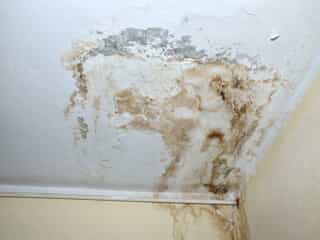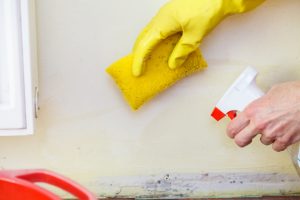When you have excess moisture in your home or business, then it can encourage mold or mildew to grow in your property. They are both fungi commonly found in properties, but their commonality doesn’t mean you shouldn’t be concerned by their presence. Mold and mildew can spread quickly and may result in property damage and health issues. However, they are two different fungi that need to be addressed properly to resolve the issue. This can prove to be difficult, though, because mold and mildew share various features.
Knowing this, you should take the time to learn the difference between mold and mildew. Because they’re so common in homes, chances are you’ll encounter the fungi in your living space at some point, and you’ll want to know how to address the problem correctly.
Continue reading to learn about mold and mildew, how to identify them, and how to conduct mildew cleaning and mold removal.
Mildew vs. Mold and How to Identify Them
What is Mildew?
Mildew is a type of fungus with flat growth and it stays on the surface of a moist area. It is either fluffy or powdery and can be a gray, white, or yellowish color. Because it is a surface fungus, mildew can be removed easily. With time, mildew will become brown or black. It mostly affects plants and crops.
What is Mold?
Mold is a type of fungus that has numerous nuclei that are identical. It grows in patches and affects the interior of a surface. Its appearance is slimy or fuzzy and can be seen as numerous colors: green, yellow, blue, gray, black, white, and brown. Because mold is a fungus that goes beneath a material’s surface, it is difficult to completely remove. It often grows on building materials, such as drywall, wood, and insulation. This is because these materials contain cellulose, which is a substance that mold uses as a food source. Additionally, mold thrives in warm, moist areas.
Mildew Specifics
What are the Different Types of Mildew?
Downy Mildew: This mildew usually begins as yellow spots but will turn brown with time. It is mostly found on potatoes, grapes, and other agricultural products.
Powdery Mildew: This mildew begins as splotches that are gray or white, but as it grows, it turns into a yellowish-brown or black. It is mostly found on flowering plants.
What Damage Does Mildew Cause?
If you inhale mildew spores, you can suffer from headaches, a sore throat, coughing, and other respiratory issues.
Mold Specifics 
What are the Different Types of Mold? What Damage Do They Cause?
Aspergillus mold is known to be the most common indoor mold, often found on clothing, insulation, paper products and walls.
According to the CDC, there are over 10,000 mold species, so there are far too many different types to identify. However, there are certain mold species that are most commonly found in households.
Alternaria: This mold has a wooly, down-like texture and can be dark brown, black, or gray. Usually, Alternaria grows in the aftermath of water damage and can be found in damp places like showers and near windows. If you are exposed to Alternaria for an extended amount of time, you may suffer from allergic reactions and asthma attacks.
Aspergillus: Known to be the most common indoor mold species, aspergillus can be black, gray, white, brown, green, or yellow. It is often found on clothing, insulation, paper products, and walls. Exposure to this mold can cause respiratory infections and allergic reactions. If you have a weak immune system, then exposure to aspergillus can cause lung inflammation.
Cladosporium: This mold species is either olive green or black in color and commonly grows on wooden surfaces, such as flooring and cabinetry, and on fabrics, such as drapery and carpeting. However, what makes Cladosporium unlike other types of mold is that it can develop in cool areas. If exposed to this mold, you may suffer from numerous respiratory issues.
Penicillium: The spores of this mold species spread easily, and its growth will appear green or blue in color. In addition, penicillium gives off musty odors and usually grows on materials that have made contact with water. This can include wallpaper, carpeting, and insulation.
Stachybotrys chartarum: This type of mold is more commonly known as “black mold” because of its black appearance. It produces a musty odor and is known to grow in damp areas. That said, if you have leaky pipes or there are areas with high levels of condensation, then black mold can easily grow there. Out of all household molds, black mold is the most dangerous one. This is because black mold can produce mycotoxins, which causes serious health issues: allergies, asthma attacks, breathing issues, fatigue, chronic sinus infections, and even depression.
Prevention and Cleaning
How Do You Prevent Mold and Mildew from Growing?

Mold removal should be addressed properly to avoid irritating the mold and worsening the problem.
The key to mold and mildew prevention is moisture control. The better job you do at keeping your property dry and free of excessive moisture, the lesser chance there is for mold and mildew growth. It is recommended that you keep humidity levels in your home somewhere between 40-50 percent. If you notice any spills or excess water, clean it up right away. If they are caused by an issue, have it resolved immediately; otherwise, you give time for mold to grow. Additionally, if you have any plants that are affected by mildew, remove them.
How Do You Clean Mildew?
Because mildew is a surface fungus, it can be cleaned easily. All you need is a scrubbing brush and a commercial cleaner. The important thing is to protect yourself while cleaning, so wear gloves and a facial mask.
When you clean mildew, make sure you also clean the areas around it. This guarantees that you effectively clean the surface and completely remove the fungus.
How Do You Clean Mold?
Unlike mildew, mold is not a surface fungus, so it is more difficult to clean. There are various home remedies you can use for mold removal, but they are not always effective. In fact, if not addressed correctly, you may irritate the mold and worsen the problem. Mold is also more dangerous to handle, because you expose yourself to the fungus. This puts you at greater risk for suffering from its negative health effects, which is why it’s best to have professionals conduct mold removal.
At ServiceMaster Professional Services, we provide professional mold remediation services to help mold-infested homes and businesses. Our professionals will locate and fix the moisture source, contain the fungus to prevent it from spreading, thoroughly remove all cases of mold in your property, and either restore or replace damaged building materials. Furthermore, we conduct our work in a safe, efficient manner, so you can trust that your property will be restored to a clean, healthy living/working space.

